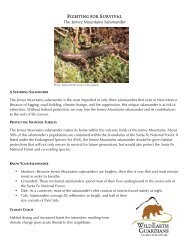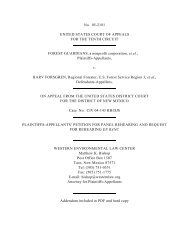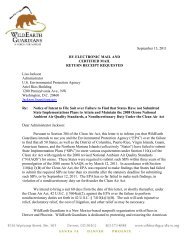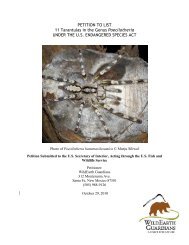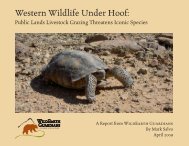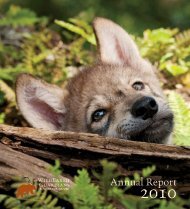PETITION TO LIST THE JEMEZ MOUNTAINS SALAMANDER ...
PETITION TO LIST THE JEMEZ MOUNTAINS SALAMANDER ...
PETITION TO LIST THE JEMEZ MOUNTAINS SALAMANDER ...
Create successful ePaper yourself
Turn your PDF publications into a flip-book with our unique Google optimized e-Paper software.
WildEarth Guardians Petition to List<br />
Jemez Mountains Salamander Under the ESA<br />
7<br />
Description<br />
Coloring<br />
Degenhardt et al. (1996) describe the Jemez Mountains salamander’s coloring as:<br />
.. uniformly dark brown above, with occasional fine gold stippling<br />
dorsally. The venter is sooty gray, being lighter on the chin and on the<br />
underside of the tail.<br />
The only similar species in New Mexico is the Sacramento Mountain salamander<br />
(Aneides hardii). The two species are easily distinguished based on geography. The<br />
Sacramento Mountain salamander is restricted to high elevations in the Capitan, White<br />
and Sacramento Mountains in south-central New Mexico (Otero and Lincoln Counties) at<br />
elevations of 9000 ft (2743 m). In contrast, the Jemez Mountains salamander is only<br />
found within portions of the Jemez Mountains range in north-central New Mexico<br />
(Sandoval, Rio Arriba and Los Alamos Counties) at elevations above 7,200 ft (2900 m)<br />
(Degenhardt et al. 1996).<br />
Lengths<br />
The average length of 296 specimens collected between 1992 and 1994, was 82.3 mm<br />
(30.9 – 134.4 mm) (Degenhardt et al. 1996). About half of the Jemez Mountains<br />
salamander’s length consists of its tail (NMDGF 1988).<br />
Dimorphism<br />
Females are larger than males at sexual maturity. Sexually mature males average 55.2<br />
mm snout-vent-length (SVL) (47-63mm) while sexually mature females average 56.2<br />
mm SVL (49-67 mm). In sexually mature males, the head may be slightly wider than the<br />
body. The mental glands of males are not evident (Degenhardt et al. 1996). Juveniles<br />
are aquatic with gills.<br />
Distinctive traits<br />
The body is long and slender with 18-20 costal grooves, with 7.5-8.5 costal grooves<br />
between the toe tips of adpressed limbs. Over 50% of specimens have four phalanges,<br />
with the fifth being much reduced, projecting just slightly beyond the foot (Brodie and<br />
Altig 1967; Degenhardt et al. 1996).<br />
Range distinctions<br />
The Jemez Mountains salamander’s range is restricted to the Jemez Mountains range in<br />
north-central New Mexico (Figure 1). The salamander has only been found in portions of<br />
Los Alamos, Sandoval, and Rio Arriba Counties (Degenhardt et al. 1996). In the<br />
mountains of these counties, the Jemez Mountains salamander exists in six fragmented



